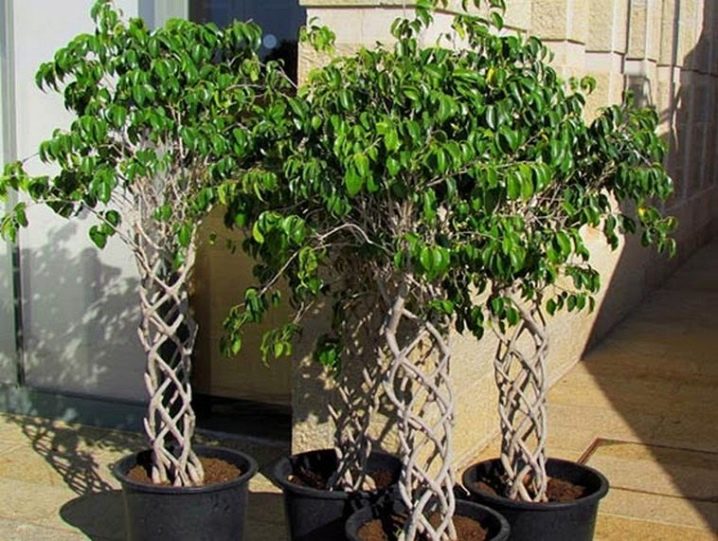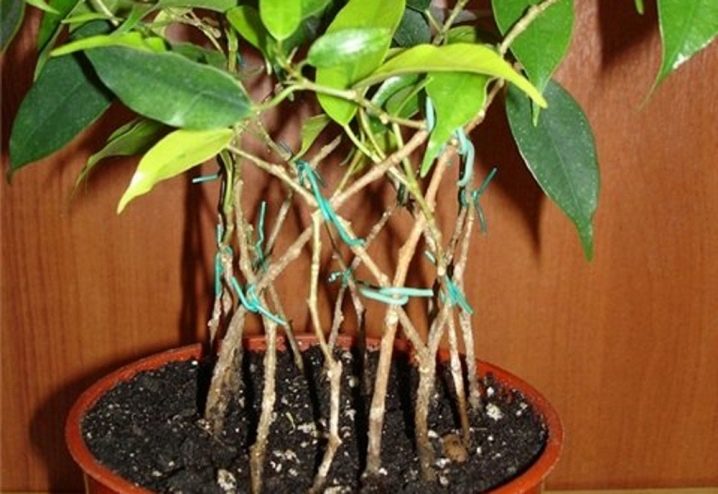Weaving ficus Benjamin: types, rules for weaving and care

Weaving ficus Benjamin allows you to create an unusual interior with your own hands, without much effort. Flexible stems can be braided or coiled, spliced, or even linked into a hedge.
Peculiarities
Weaving ficus Benjamin is easy to implement if you take young shoots, and then grow them yourself to a mature state. If you try to do something with mature bushes, then nothing will come of it. The reason is that it is possible to bend or twist the trunks only until they become stiff. In addition, the young stalks of the Exotic ficus are still devoid of bark, which means that they can be transformed in a spiral, braided into a braid, or directed in the direction opposite to their growth.
Views
Ficus Benjamin is ideal for weaving at home compositions of various levels of complexity.
Scythe
The pigtail trunk is the simplest and most popular way to decorate a plant. The joining of the trunks begins three months after the planting of the seedlings. It is not recommended to delay from the beginning, otherwise an unpleasant tuberosity will appear, and the branches will become stiff. All shoots must be of the same height and diameter. Different parameters in this case will not only disrupt the aesthetic appeal, but will also lead to the death of weaker processes.

If desired, an ordinary braid can be complicated: leave one straight shoot in the center and weave around it.
Spirals
The spiral is considered another uncomplicated way of weaving Benjamin's ficus. To create it, one shoot is enough, which is obtained from a seedling with a height of 10 to 15 centimeters. Even at the planting stage, it is important to place a straight support of the required diameter next to the ficus.
Hedge
To create a hedge, it is necessary to plant any number of seedlings in a row. No additional props are required - the main thing is to maintain the same distance between individual ficuses. With the course of growth, the bushes can be intertwined in any way you like.
Lattice
The creation of the trellis requires a minimum of 5 seedlings, although it is best to prepare 8 to 10 shoots with the same diameter and height. The tub should be spacious, ideally an oval shape. A plastic or cardboard tube is located in the center, allowing you to quickly cross the barrels. The pipe diameter is determined depending on the number of trunks used.

How to braid?
In principle, braiding any shape is not particularly difficult if you prepare the seedlings correctly and use the schemes presented on the Internet.
Selection and preparation of seedlings
In order for the trunks of Benjamin's ficus to intertwine in the future, it is necessary initially to correctly select the seedlings for planting. Their height is 10 centimeters and corresponds to the maximum flexibility that a plant can have. In addition, it is at this stage that there is no crust, which negatively affects elasticity. To braid the simplest compositions, you will need at least 3 seedlings, although it is better to take more.
If you plan to execute a more complex scheme, for example, a hedge, you will need an amount that can completely fill the diameter of the planting container.
It is important to maintain an equal diameter of the shoots, otherwise the overall picture will be spoiled. This is especially true in the case of braids or circular weaving. It is better to plant the stems in early spring - so their development will be quite fast, in a month and a half it will be possible to start creating a decorative composition. Separately, it is worth mentioning the splicing of the trunks - in this case, partially woody seedlings will be required, the length of which reaches 15 centimeters. While they are growing, the bark will have to be pruned regularly where they meet. This will have to be done very carefully so as not to harm the plant.

A pot or pots are selected even at the stage of thinking over the composition. A hedge will fit perfectly in a wide container with high sides in the shape of a rectangle or oval. An elegant and narrow pigtail or spiral will be enough for an ordinary pot. In addition, we must not forget about the number of shoots used - this also determines the size of the tub.
When planting ficus at the bottom of the pot, it is imperative to organize a drainage layer of brick chips, pebbles, expanded clay or ordinary rounded pebbles. The height of this layer is determined depending on the height of the container itself. Drainage will prevent waterlogging and improve soil aeration. If by that time the cuttings have formed too long roots, or some of them have already been damaged, then it is worth cutting them off. Part of the soil is laid on top of the drainage. It can either be purchased ready-made in the store, or you can create it yourself by combining peat, river sand and leafy soil.
The seedling is installed so that the root collar remains above the level of the ground surface. The roots are straightened and covered with earth. It is important to make sure that there is at least a couple of centimeters between the ground and the edge of the pot. The soil is slapped lightly and irrigated with warm water enriched with growth stimulants.

The first fertilization is allowed only a month after the seedlings have taken root.
Technology
It is better to start braiding the shoots when they reach 13 or 15 centimeters, but have time to finish everything until the trunks are covered with bark. To implement an idea with your own hands, it is enough to find schemes on the Internet, and then implement them step by step. For example, the formation of a normal pigtail comes from 3 or 6 seedlings. The weaving should not be tight - it is better to leave gaps, the sizes of which can be adjusted with pencils or sticks of the same diameter made of wood. Each new loop can be created every one and a half or two months.
It is better to fix the top slightly with a cloth ribbon or woolen thread. Again, excessive efforts should not be made, otherwise the nutrition of the ficus will be disrupted, and one of the shoots may even die. During the weaving of the trunks, the shoots on which the buds appear, looking inward, will have to be cut off. If necessary, the crown should also be shortened to achieve a more attractive shape. Experts recommend, while the shoots are still growing, to fix the upper layers on supports.
Before the immediate start of weaving, it would be good to water the ficus abundantly to give the stems additional flexibility. You can also carry out a more complex procedure - take the ficus to the bathroom, protect the soil with plastic wrap and provoke vaporization by turning on hot water. The pot should remain in this state until the flexibility of the plant increases.

To create a spiral, it is enough to braid the growing shoot around a nearby support. The latter must be securely fixed, otherwise the development of the trunk will be disrupted. The double helix is formed according to the same principle, only the shoots are directed parallel to each other. A spliced variation of the double helix is made by cutting off a portion of the bark where both shoots meet. In all cases, the circular weaving is secured with a thread that cannot cut the plant.
It is important to ensure that the height of the stanchion matches the height of the trunk.
Shoots, which are to form a lattice, are planted in a line along the diameter of the installed tube, keeping an equal gap between them. Over time, they are directed in the desired direction using wire or cling film. If at some points the shoots are to be connected, then it is better to gently fix the place with a woolen thread or gauze cloth. If the side shoots begin to knock out of the composition, then it is better to cut them off.
By the way, some experts believe that the lattice does not have to be flat at all - it can be given any unusual bend.

Follow-up care
When weaving ficus, the main task is to grow cuttings of the required size, and then connect them according to a certain pattern. Therefore, when the bush stops developing, and the weaving is completed, it remains only to remove the props and take care of Benjamin's ficus as usual. We are talking about high-quality lighting, ideally coming from a window facing east, at a temperature of 15 degrees Celsius, high air humidity and protection from drafts. Every month the bush is washed under a warm shower.
Specialist recommendations
Creating unusual designs, sooner or later the trunks and shoots of individual ficuses will have to be fixed. Materials such as twine, cling film, wire or thread are suitable for this purpose. To accelerate the accretion of individual parts, you can first cut off pieces of bark from them, then wipe off the juice and connect with a fixer. It is recommended to change the material used once a month to prevent thread or wire from growing into the bark. In addition, it is important to remember that strong tightening is harmful to the ficus.
































The comment was sent successfully.